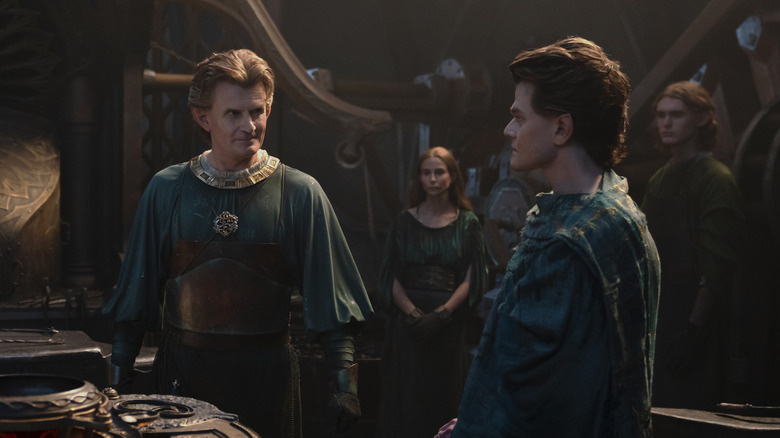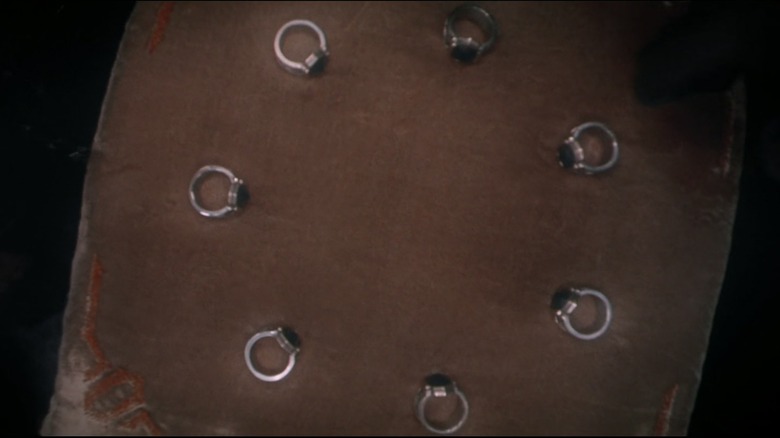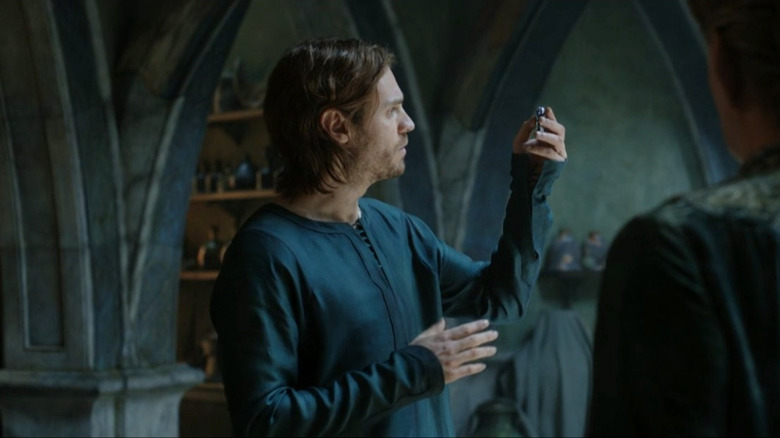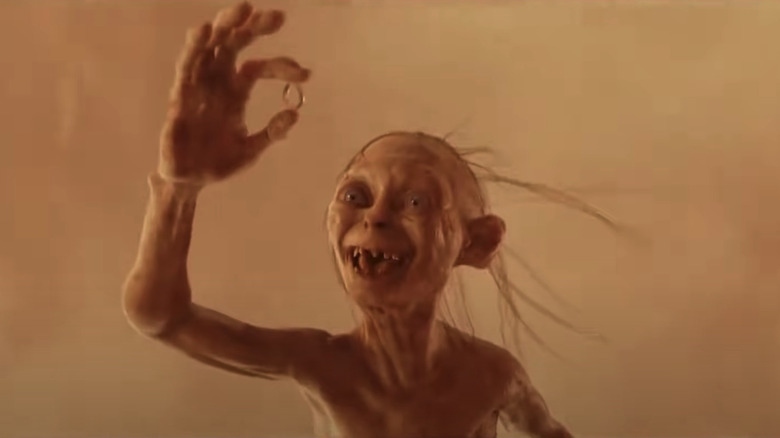Lord Of The Rings: Who Actually Makes The Rings Of Power?
Amazon Studios' "The Lord of the Rings: The Rings of Power" spent Season 1 building up to the forging of the Three Elven Rings. Season 2 is diving into the creation of the rest of its titular jewelry. As the series' five-season story arc continues to unfold, showrunners J.D. Payne and Patrick McKay have changed the Tolkien timeline while navigating the lack of certain rights to and sparseness of Tolkien's source material for their Second Age show.
As the creators have made artistic adjustments to Tolkien's original story, this has led to multiple people getting in on the on-screen ring-making action, which begs the question: Who actually makes the Rings of Power in Tolkien's books? The answer is threefold: the Elven master craftsman Celebrimbor, the group of artisans that he leads called the Gwaith-i-Mírdain, and Sauron (both as himself and under his secret name Annatar, Lord of Gifts).
This is already complicated in the books, and the adaptation is only adding to the confusion. The introduction of Sauron as the secretive Human character Halbrand (Charlie Vickers) was a befuddling Season 1 mislead that ends with Halbrand directly influencing the creation of the Three Rings (more on that in a minute). Galadriel (Morfydd Clark) and Elrond (Robert Aramayo) are also present and semi-involved. Season 2 marketing has Vickers returning as Sauron's canon-accurate Annatar persona, which he is supposed to use to help the Elven smiths of Eregion make many more Rings of Power — not just the 20 Rings of Power from Tolkien's famous Ring-verse. By the time they're done, there will probably be a lot of these magic baubles in circulation. Clarifying who made which ones on the show and in the books is starting to become a bigger task than the forging of the rings themselves.
Who makes which Rings of Power in the books?
Early in the "Fellowship of the Ring" book, Gandalf explains the history of the Rings of Power to Frodo, saying, "In Eregion long ago many Elven-rings were made, magic rings as you call them, and they were, of course, of various kinds: some more potent and some less." The wizard goes on to say that the 20 Rings for Men, Elves, Dwarves, and Sauron are the most powerful of these. However, "The Silmarillion" explains that magical Ring-making was a common activity for the Eregion smiths, called the Gwaith-i-Mírdain. They developed their skills for centuries (guided by Sauron's teachings under his guise as Annatar, Lord of Gifts), until the book tells us, "they took thought, and they made Rings of Power."
The Elven smiths of Eregion collectively make an unknown number of Rings with the help of Sauron's teachings and knowledge as the imposter Annatar. Out of all that activity, two events are called out specifically: Sauron makes the One Ring in secret, and Celebrimbor forges the Three Rings on his own without Sauron's help. Overall, this is fairly easy to follow and would only become more difficult if you added even more forms of Sauron to the mix or had him handling the Three Rings before they were forged — which is precisely what "The Rings of Power" has done.
Who makes the Rings in The Rings of Power show?
"The Rings of Power" has, thus far, had a tough time following Tolkien's original path for the forging of the Rings of Power. The show kicks things off by ending Season 1 with the forging of the Three Elven Rings, an event that is supposed to come much later, just before the One Ring is forged in Mount Doom. Complicating things even more is the fact that Sauron is present for the forging of these three Rings in his non-canonical Halbrand form. He even touches the mithril used to forge the Rings. This contradicts "The Silmarillion," where it says, "the Three remained unsullied, for they were forged by Celebrimbor alone, and the hand of Sauron had never touched them."
Now, Sauron is back, this time disguised as the book-accurate Annatar, to forge the rest of the Rings of Power and then whip up his own Ruling Ring. To be fair, there are some understandable reasons for the way the show is handling the story. For instance, "Rings of Power" writer Gennifer Hutchison told Looper right after the Season 1 finale that creating the Elven Rings first was due to the Elf-focused Season 1 story, adding, "Coming to that ending for this season was always, at least very early on, the plan because [we're] focusing on that story and making sure we're servicing that one for this season."
It's also worth noting that we don't see Halbrand touch the rings once they're actually rings. He handles their material before they're forged. Perhaps "unsullied" doesn't equate to "untouched," and their newly forged power still remains pure in the eyes of the adapters.
Where do the Rings of Power end up?
The Rings of Power project may be an accidental collaborative effort between Elves and the Dark Lord, but once those groups break, the Rings and their makers go their separate ways. After a dramatic journey, the One Ring ends up back in Mount Doom, destroyed along with its deceitful maker. (Although Sauron doesn't actually die — it's much worse.)
As for where the other Rings of Power end up, the Three Elven Rings are taken west to the Undying Lands. The Nine Rings for Mortal Men perish, along with their owners, when the One Ring goes up in flames. As for the Seven Dwarven Rings, Gandalf says the "Fellowship of the Ring" book that Sauron gets three of these back while the Dragons melt the other four. Presumably, the surviving three meet the same fate as the Human Rings when the One Ring is destroyed.
And the lesser rings? The countless other magical trinkets of the Elven smiths of Eregion? Apart from Tolkien mentioning that they exist, there's no accounting for them. The author never tells us where they end up, how many there are, or if they're of any consequence.



